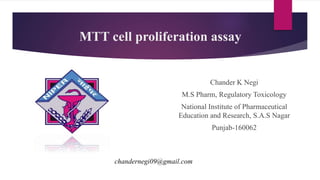
MTT cell proliferation assay
- 1. MTT cell proliferation assay Chander K Negi M.S Pharm, Regulatory Toxicology National Institute of Pharmaceutical Education and Research, S.A.S Nagar Punjab-160062 chandernegi09@gmail.com
- 2. MTT assay The MTT assay and the MTS assay are colorimetric assays for measuring the activity of enzymes that reduce MTT or close dyes (XTT, MTS, WSTs) to formazan dyes, giving a purple color The main application allows to assess the viability (cell counting) and the proliferation of cells (cell culture assays) It can also be used to determine cytotoxicity of potential medicinal agents and toxic materials, since those agents would stimulate or inhibit cell viability and growth
- 3. • These reductions take place only when reductase enzymes are active, and therefore conversion is often used as a measure of viable (living) cells. • However, it is important to keep in mind that other viability tests (such as the CASY cell counting technology) sometimes give completely different results, as many different conditions can increase or decrease metabolic activity. • Changes in metabolic activity can give large changes in MTT or MTS results while the number of viable cells is constant. • When the amount of purple formazan produced by cells treated with an agent is compared with the amount of formazan produced by untreated control cells, the effectiveness of the agent in causing death, or changing metabolism of cells, can be deduced through the production of a dose-response curve. Continued..
- 4. • The MTT Cell Proliferation and Viability Assay is a safe, sensitive, in vitro assay for the measurement of cell proliferation or, when metabolic events lead to apoptosis or necrosis, reduction in cell viability. • Cells are cultured in flat-bottomed, 96-well tissue culture plates. The cells are treated as per experimental design and incubation times are optimized for each cell type and system. • The tetrazolium compound MTT (3-[4, 5-dimethylthiazol-2-yl]-2, 5- diphenyltetrazolium bromide) is added to the wells and the cells are incubated. MTT is reduced by metabolically active cells to insoluble purple formazan dye crystals by mitochondrial enzymes associated with metabolic activity. The reduction of MTT is primarily due to glycolytic activity within the cell and is dependent upon the presence of NADH and NADPH Continued..
- 5. • Detergent is then added to the wells, solubilizing the crystals so the absorbance can be read using a spectrophotometer. Samples are read directly in the wells. • The optimal wavelength for absorbance is 570 nm, but any filter that absorbs between 550 and 600 nm may be used. • The data is analyzed by plotting cell number versus absorbance, allowing quantitation of changes in cell proliferation. • The rate of tetrazolium reduction is proportional to the rate of cell proliferation Continued..
- 6. Reagent Storage MTT Reagent 2 - 8° C Detergent Reagent 18 - 24° C Reaction A microtiter plate after an MTT assay. Increasing amounts of cells resulted in increased purple colouring Reagents and storage conditions
- 7. Features: Convenient → Stabilized formulation is stored in your refrigerator and does not require thawing before use Non-isotopic → Assay for cell proliferation, cytotoxicity, and viability does not require isotopic reagents Fast → High throughput microplate format Flexible → The reaction product can be visualized directly by microscopy to evaluate cell to cell reactivity, or solubilized and evaluated by microplate reading. Safe → Reaction product is solubilized using a non-organic solvent Common methods for determining cell viability depend upon membrane integrity (e.g. trypan blue exclusion), or incorporation of nucleotides during cell proliferation (e.g. BrdU or 3H-thymidine)
- 8. These methods are limited by the impracticality of processing large numbers of samples, or by the requirement for handling hazardous materials The MTT Assay, in contrast, provides a rapid and versatile method for assessing cell viability. The assay is used to measure changes in cell proliferation. In actively proliferating cells, an increase in MTT conversion is spectrophotometrically quantified. Comparison of this value to an untreated control provides a relative increase in cellular proliferative activity. Conversely, in cells that are undergoing apoptosis, MTT reduction decreases, reflecting the loss of cell viability Continued..
- 9. Applications: Cell proliferation assays Cytotoxicity analysis Apoptosis screening
- 10. Plate cells into 96-well tissue culture plates. In general, cells should be seeded at densities between 5000 and 10,000 cells per well since they will reach optimal population densities within 48 to 72 hours Carry out your experiment by adding chemicals or biological agents into appropriate well. The final volume of tissue culture medium in each well should be 0.1mL, and the medium may contain up to 10% Fetal Bovine Serum Thaw one vial of MTT solution for each 96-well plate assay Note: If sediment is present in the solution, heat the solution to 37°C and swirl gently until a clear solution is obtained. Add 10μL MTT solution to each well. Mix by tapping gently on the side of the tray or shake briefly on an orbital shaker. Experimental Protocol
- 11. Incubate at 37°C for 4 hours. At high cell densities (>100,000 cells per well) the incubation time can be shortened to 2 hours Add 200μL DMSO into each well to dissolve the formazan by pipetting up and down several times Measure the absorbance on an ELISA plate reader with a test wavelength of 570 nm and a reference wavelength of 630 nm to obtain sample signal (OD570-OD630). Continued..
- 12. J Immunol Methods 65, 55 (1983); 2. J Neurochem 69, 581 (1997); 3. Arch Biochem Biophys 303, 474 (1993); 4. Cancer Res 51, 2515 (1991) Berridge MV, Herst PM , and Tan AS. Tetrazolium dyes as tools in cell biology: new insights into their cellular reduction. Biotechnology Annual Review, 11: 127-152 (2005) References
